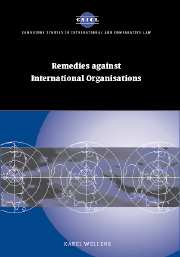Book contents
- Frontmatter
- Contents
- Acknowledgements
- List of abbreviations
- Introduction
- Part I General features of remedies against international organisations
- Part II Procedural aspects of remedial action against international organisations
- Part III Substantive outcome of remedial action against international organisations
- Part IV Alternative remedial action against international organisations and options for the future
- 16 Introduction to alternative remedial action against international organisations and options for the future
- 17 Pre-remedial action
- 18 Non-legal alternative remedial action
- 19 Amendment of existing judicial remedies
- 20 An inevitable role for the International Court of Justice
- Conclusion
- Bibliography
- Index
- CAMBRIDGE STUDIES IN INTERNATIONAL AND COMPARATIVE LAW
16 - Introduction to alternative remedial action against international organisations and options for the future
Published online by Cambridge University Press: 13 July 2009
- Frontmatter
- Contents
- Acknowledgements
- List of abbreviations
- Introduction
- Part I General features of remedies against international organisations
- Part II Procedural aspects of remedial action against international organisations
- Part III Substantive outcome of remedial action against international organisations
- Part IV Alternative remedial action against international organisations and options for the future
- 16 Introduction to alternative remedial action against international organisations and options for the future
- 17 Pre-remedial action
- 18 Non-legal alternative remedial action
- 19 Amendment of existing judicial remedies
- 20 An inevitable role for the International Court of Justice
- Conclusion
- Bibliography
- Index
- CAMBRIDGE STUDIES IN INTERNATIONAL AND COMPARATIVE LAW
Summary
In Part I of this study, remedies against international organisations were placed within the context of the overall accountability regime for these actors, against the background of the more general problem of remedies in international law and in comparison with remedies normally available against states. The various remedies have to be appropriate for the different levels of accountability and entail different standing for potential claimants.
Part II was devoted to procedural aspects of remedial action envisaged by the various categories of claimants, with non-state claimants facing the common procedural obstacle of the jurisdictional immunity of international organisations before domestic courts.
The different substantive outcome of remedial action undertaken by staff members and private claimants was reviewed in Part III.
Based upon the analysis made so far, this fourth and final Part looks at alternative remedial action and some options for the future. Attention will be paid to pre-remedial action (chapter 17), to non-legal alternative remedial action (chapter 18), to amending existing judicial remedies (chapter 19) and to the inevitable role for the International Court of Justice (chapter 20), so that they can fit in with the unusual status of international organisations.
A few more general observations are appropriate at this stage.
The existence of a legal obligation incumbent upon international organisations to provide remedial mechanisms to states and non-state entities whose interests, legal or otherwise, have been or are likely to be affected by acts, actions or omissions of international organisations cannot seriously be doubted.
- Type
- Chapter
- Information
- Remedies against International Organisations , pp. 169 - 171Publisher: Cambridge University PressPrint publication year: 2002

